Dual review of the Xperia Z3 and Z3 Compact
As usual, at the end of autumn, Sony Mobile has another update of its flagship models, and this time it affected not only the full-sized Xperia Z3, but also its smaller version - Z3 Compact. At first glance, it may seem that both smartphones have not changed much, however, upon closer examination, the difference is quite significant. In the near future, the tablet should also be on sale - the Z3 Tablet Compact, well, you can familiarize yourself with the dual review of new smartphones now. Forward!

Appearance and Ergonomics
External changes were quite significant. The Z3 has rounded metal frames with polycarbonate inserts at the corners - they are designed to soften the blow when dropped, to distribute the load and try to keep the screen intact. The plugs became smaller and got rounded corners, in addition, not too graceful speaker holes on the bottom end disappeared, and the speaker itself moved to the front panel.
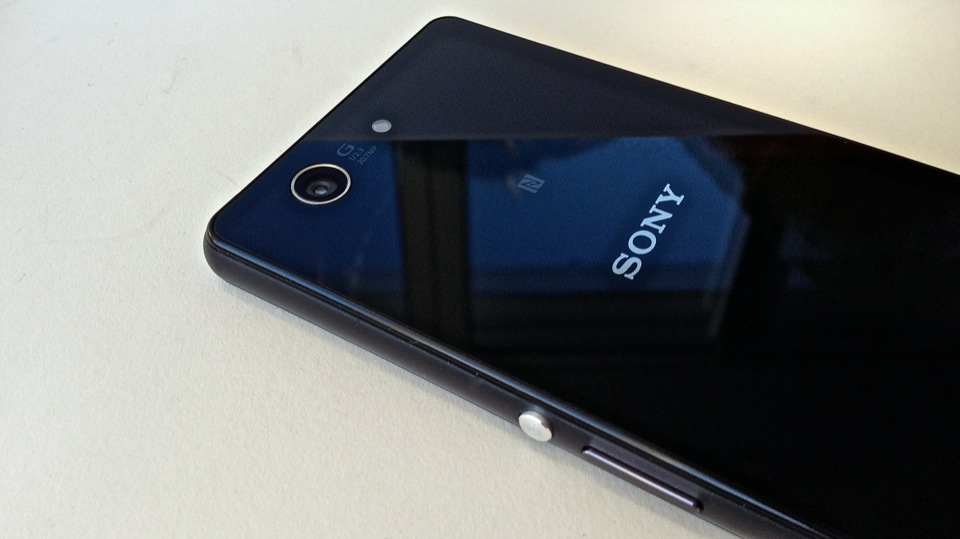
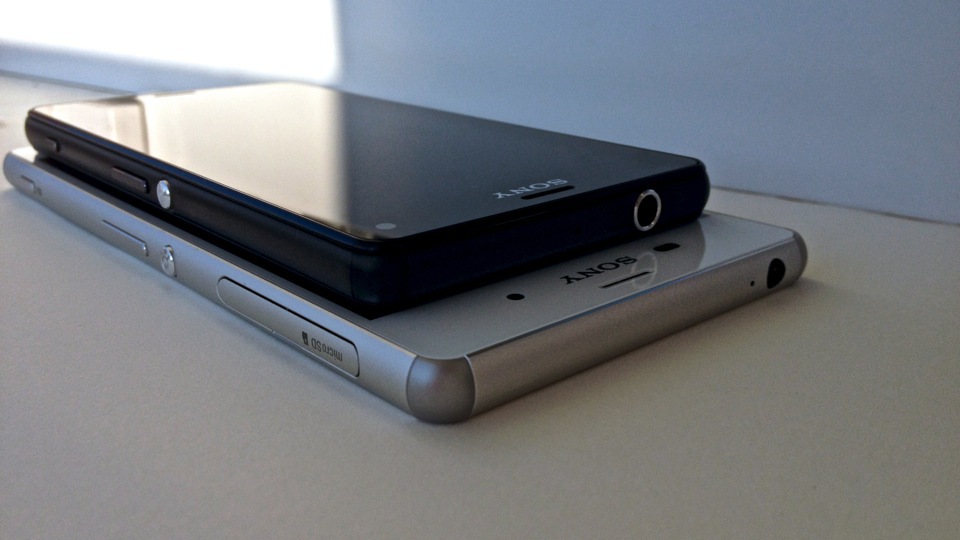
The controls and slots remained in place, except that the SIM card slot now requires the installation of a Nano-SIM format card - keep in mind and, if necessary, change the card in the cabin when buying. Compact has the same situation. A single-sim version of Z3 participated in the testing, however, a model with two slots should also appear on sale, and the use of one card with LTE is allowed - it can be installed in any slot.
The case has become thinner by 1 mm and a bit more compact - due to the reduction of the frames around the screen. The device fits in your hand more conveniently than Z1 / Z2, and the weight loss, albeit insignificant, is still felt and this can also be safely written as a plus.

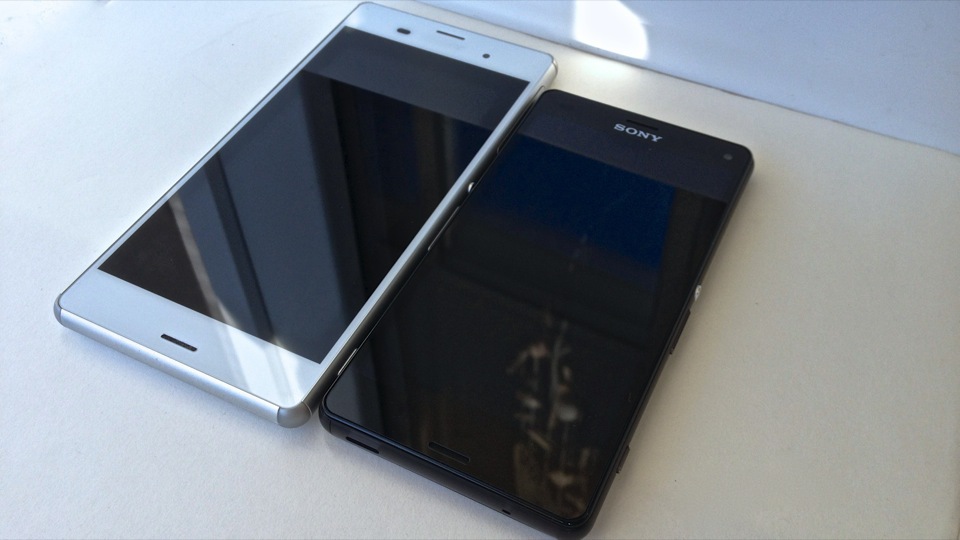
If the Z1 Compact was criticized for the plastic back wall, then the new generation does not have such a problem and the back panel is made of tempered glass. The translucent polycarbonate frame looks quite stylish, especially with a black body, in addition - it copes well in the role of a “bumper” that will protect the phone when it falls. The plugs became larger and more reliable, but the buttons remained in the same places as before, since they were located very well. The buttons are still short and clear, they do not hang out and are easily blind. Well, the most interesting thing - with the same dimensions as the previous model, the screen (again, due to the reduction in the thickness of the frames) has become larger and its diagonal is now 4.6 inches. The factory film has sunk into the past, now the glass itself copes well with protection from scratches, and the finger glides perfectly on them,
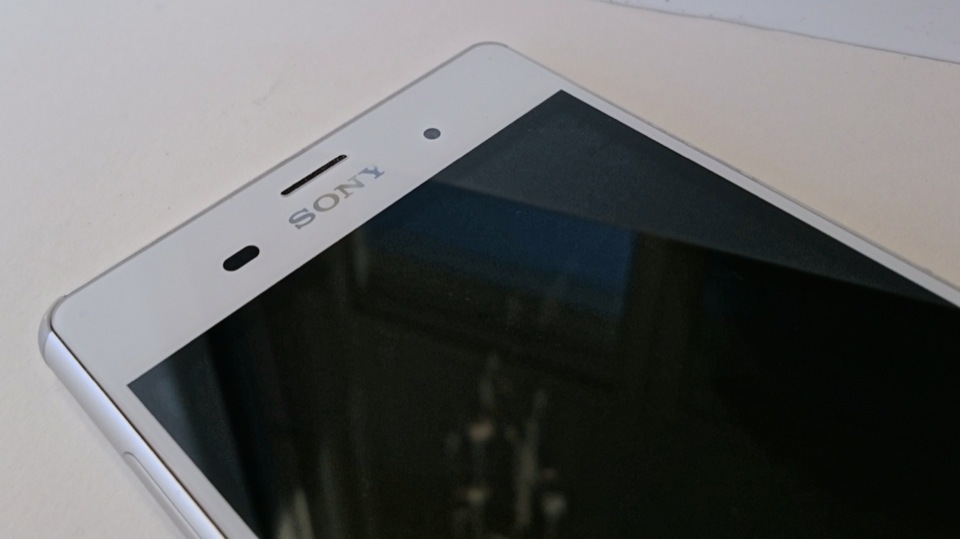
As for the color scheme, the Z3 can be black, white, copper and silver-green, and the Z3 Compact is available in black, white, orange and mint green.
Iron and performance
The quad-core Snapdragon 801AC was overclocked to 2.5 GHz, the RAM for the Z3 is 3 GB, and for the Z3 Compact - 2. Despite a slight increase in performance, in practice it is felt quite strongly, this is due to the optimized firmware. Both devices instantly exit the lock mode, there are absolutely no hints of delays and slowdowns when performing any operations. Standard applications, such as the camera or Walkman, run in less than a second. The most gluttonous games, such as Asphalt 8, work perfectly with maximum settings.
You can find the test results below.
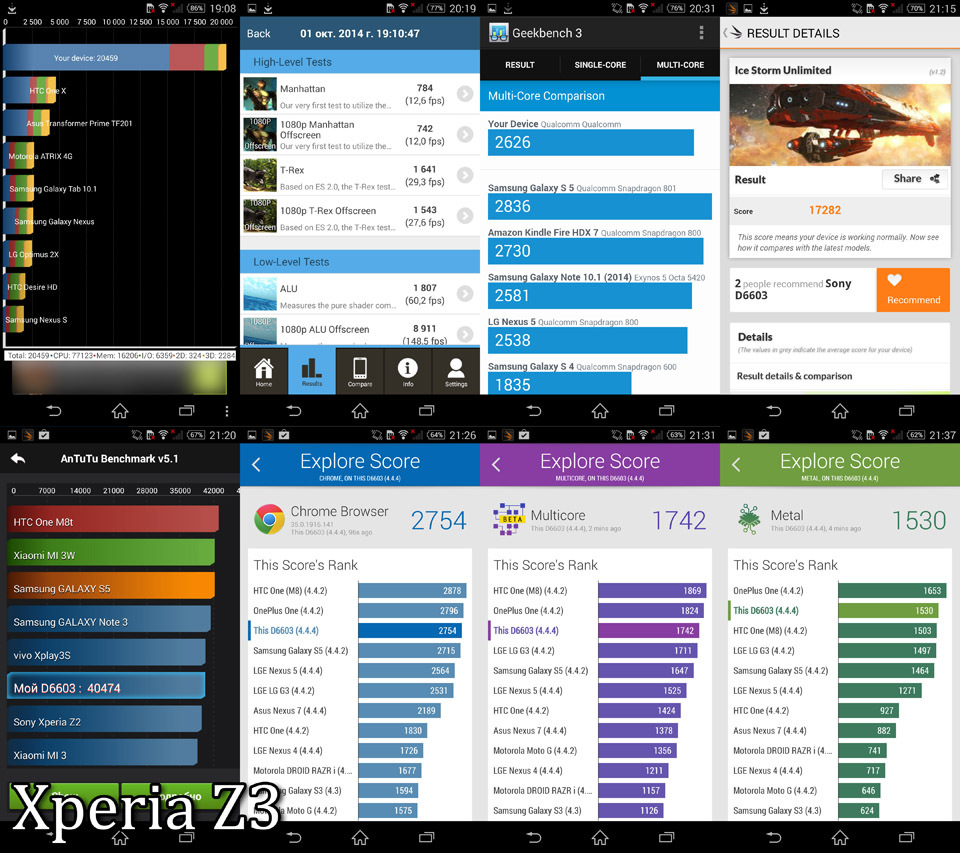
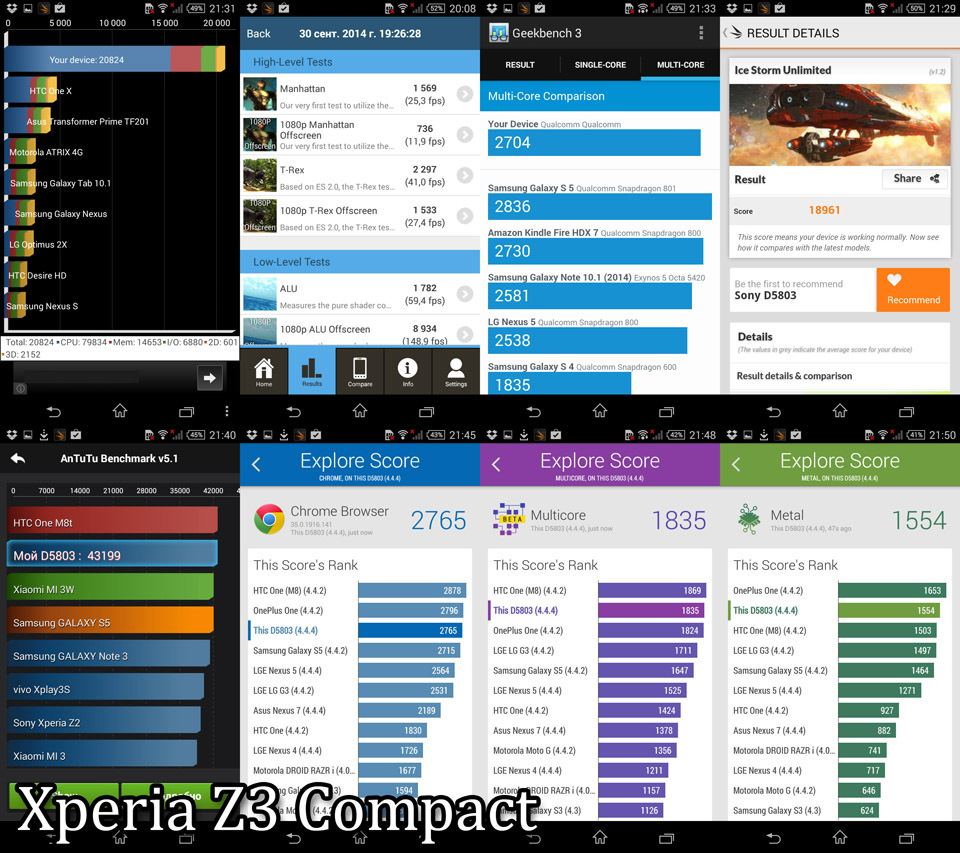
Display
Let's start with the bigger one. The Z3 has exactly the same 5.2-inch display with an IPS-matrix and a resolution of 1920 × 1080. If a year ago some complained about insufficient viewing angles and a small margin of brightness, then the Z3 certainly does not have such problems (as well as its compact counterpart). The image practically does not fade even at the maximum tilt possible, and the brightness has to be even reduced a little. A positive effect on image quality and the absence of an air gap - this makes a significant contribution to the fight against glare. As for saturation, in the mode of maximum brightness, the colors even become too juicy and not everyone may like it, however, the color rendition can be set as you like, for which several color modes and a special utility for setting white balance are provided.
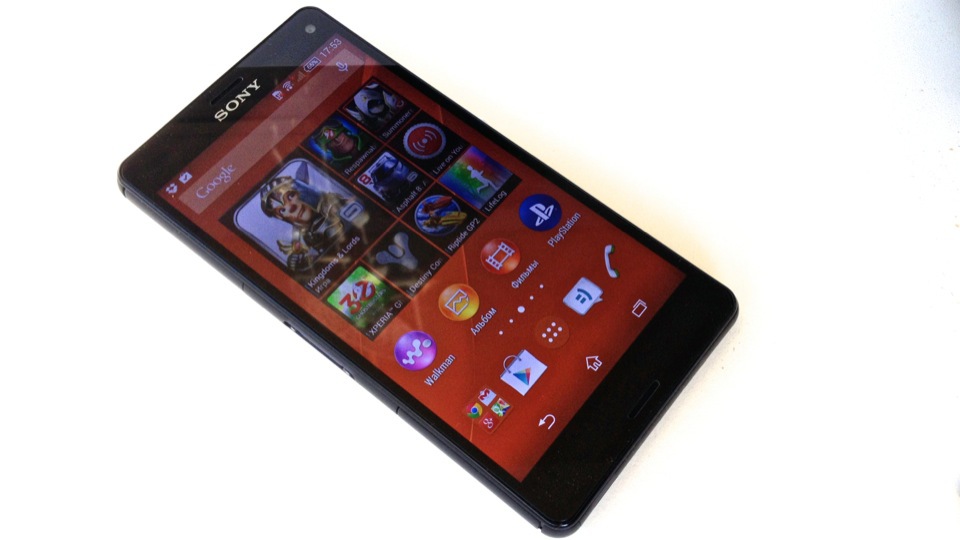
The Z3 Compact screen, as we already said, increased to 4.6-inches, but the resolution remained the same - 1280x720, this led to a certain decrease in image density to 319 ppi, but it is not possible to notice this with the naked eye and the picture looks the same clear, detailed and saturated. You can only see pixels if you really, really try.
Both displays support up to 10 simultaneous taps, have a glove mode and correctly sense wet fingers.
Sound
The sound engine and standard Walkman audio player have undergone some changes: the DSEE HX function has appeared, which, as far as possible, recovers frequencies deleted from compressed files and significantly improves mp3 sound quality, in addition, presets for various models of headphones and the ability to transmit HiRes audio via USB. Familiar to many, the ClearAudio + function allows you to not set the settings manually, but applies all the "enhancers" in a comprehensive way. The maximum volume in the headphones has noticeably increased, now you can not twist it to the full and do not use third-party tools to increase the maximum level. The built-in speakers also became louder and even got some basses - in terms of sound level they can be compared with a small bluetooth speaker. As for the conversational dynamics, here, as usual,
The
20.7-megapixel camera has acquired a new level of sensitivity of ISO 12800, which allows you to shoot in low light conditions and get high-quality images with low noise. By default, the camera shoots in automatic mode with a resolution of 8 megapixels and this, in my opinion, is quite enough, in addition, compared to last year, the auto mode began to work extremely well and practically does not need manual settings, except in special cases. In manual mode, you can adjust the exposure, white balance, set resolution, sensitivity, metering and focusing modes, and use the HDR mode.

Additional features appeared, for example, Sound Photo (photo with sound), Multi-camera (shooting a single object from different angles using several smartphones synchronized via Wi-Fi), simultaneous shooting with the front and main cameras, recording video from the screen (screencast), slow video recording, shooting in 4K resolution, as well as new effects of augmented reality - now you can not only launch dinosaurs into the room, but also draw various three-dimensional figures in the air or throw bombs from the window.
In camera mode, you can use third-party downloadable applications, such as Timelapse for faster shooting of sunsets and sunrises or Vine to record short clips and send them to Twitter. For their quick launch, you do not need to turn off the camera and look for the corresponding icon in the application list, just switch the shooting mode.
Below you can see photos taken by Z3 and Z3 Compact cameras. The shooting was carried out automatically.









Software
Both smartphones have on board Android 4.4.4 with a proprietary shell, which has changed somewhat in appearance and has become noticeably smoother. The design of the clock on the lock screen has changed, and the parallax effects when scrolling through the screens have become a little more beautiful. If you don’t like the new design, you can switch to a more familiar one or download one of the themes offered by the Xperia Themes project, since there are more and more of them every day.
The set of pre-installed applications was replenished with the Deezer music service (it is now integrated into Walkman), the Lifelog application (we talked about it in detail in the SmartBand review), the Live on YouTube live broadcast system, and AVG antivirus. The familiar Evernote, OfficeSuite, TrackID, Socialife and File Commander have not gone anywhere. If necessary, these applications can be safely removed.
Z3, Z3 Compact and Z3 Tablet Compact got the ability to broadcast images from the PlayStation 4. The device can be attached to the DualShock4 gamepad (requires the optional GCM10 accessory) and broadcast the image to it. A tablet can play the role of the main screen or can be additional, too, if the game has a corresponding function. So, for example, you can watch the news on TV without breaking away from the game, which will be transferred to the tablet.
Protection
The protection class of both models has increased to IP68, which means complete protection against dust and performance when immersed in water to a depth of one meter for no more than 30 minutes. The main thing is to check the tightness of the plugs before bathing. The reliability of the plugs is beyond any doubt, however, in order to avoid deformation, it is still better not to open them again and use the dock for charging.
Of course, the screens cannot correctly respond to clicks under water, but the hardware button for launching the camera comes to help, as always. As for durability, we didn’t dare to take a serious crash test, but both devices endure falls from a small height well - polycarbonate shock absorbers really save glass from damage.
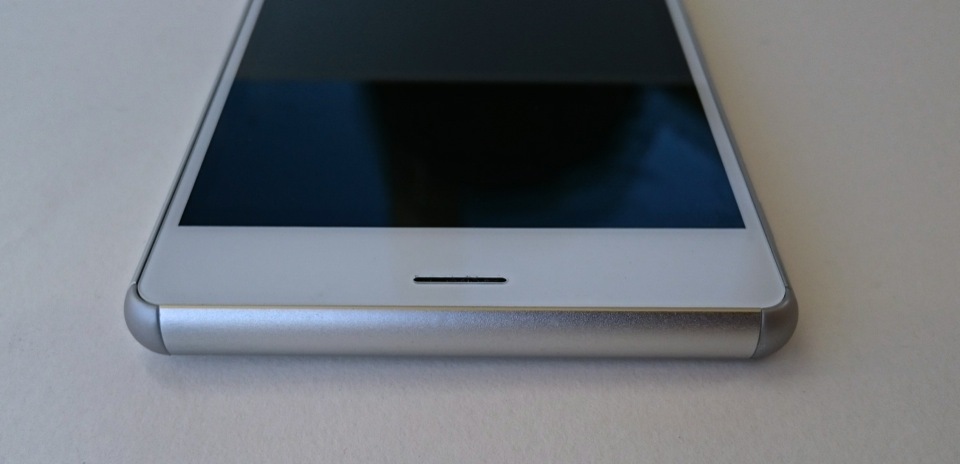
Autonomy
The battery capacity of the Z3 decreased from 3200 to 3100 mAh, but this did not affect autonomy, moreover, Z3 and Z3 Compact, according to phonearena.com, became the most “long-playing” of the flagship smartphones . For example, Z3 can continuously work for about nine and a half hours with maximum load, and with normal use, one charge lasts for two days. “Compact”, due to the small screen, consumes less power and it needs enough batteries with a capacity of 2600 mAh, which, nevertheless, allows it to work even longer than the Z3. Do not forget about the STAMINA mode, which, if necessary, can extend the battery life from one charge to almost a week.

Summary
If the improvements of the “big” Z3 can be called, in general, cosmetic, since there was nothing much to improve, but in the case of “Compact” a very serious and large-scale work was carried out, approximately the same as in the case with Z1 and Z2. Personally, I think this format of smartphones is ideal and I always prefer 4-inch models to “shovels” and, if I had some complaints about the Z1 Compact, then the new model seemed to me just great and I did not find any noticeable shortcomings, I’m happy I will use it myself.
Xperia Z3 specifications :
Processor : 4-core Qualcomm Snapdragon 801, 2.5 GHz
Memory : 3 GB operational, 16 GB internal, SD card slot
Video accelerator : Adreno 330
Display: 5.2 inches, IPS, 1920x1080
Camera : Exmor RS 1 / 2.3``, 20.7 megapixels
Battery : 3100 mAh
OS : Android 4.4.4 KitKat
Protection : IP68
Dimensions : 146 x 72 x 7.3 mm
Specifications Xperia Z3 Compact:
Processor : 4- nuclear Qualcomm Snapdragon 801, 2.5 GHz
Memory : 2 GB operational, 16 GB internal, SD card slot
Video accelerator : Adreno 330
Display : 4.6 inches, IPS, 1280x720
Camera : Exmor RS 1 / 2.3 '', 20.7 megapixels
Battery : 2600 mAh
OS : Android 4.4.4 KitKat
Protection : IP68
Dimensions : 127.3 x 64.9 x 8.6 mm
Appearance and Ergonomics
External changes were quite significant. The Z3 has rounded metal frames with polycarbonate inserts at the corners - they are designed to soften the blow when dropped, to distribute the load and try to keep the screen intact. The plugs became smaller and got rounded corners, in addition, not too graceful speaker holes on the bottom end disappeared, and the speaker itself moved to the front panel.
The controls and slots remained in place, except that the SIM card slot now requires the installation of a Nano-SIM format card - keep in mind and, if necessary, change the card in the cabin when buying. Compact has the same situation. A single-sim version of Z3 participated in the testing, however, a model with two slots should also appear on sale, and the use of one card with LTE is allowed - it can be installed in any slot.
The case has become thinner by 1 mm and a bit more compact - due to the reduction of the frames around the screen. The device fits in your hand more conveniently than Z1 / Z2, and the weight loss, albeit insignificant, is still felt and this can also be safely written as a plus.
If the Z1 Compact was criticized for the plastic back wall, then the new generation does not have such a problem and the back panel is made of tempered glass. The translucent polycarbonate frame looks quite stylish, especially with a black body, in addition - it copes well in the role of a “bumper” that will protect the phone when it falls. The plugs became larger and more reliable, but the buttons remained in the same places as before, since they were located very well. The buttons are still short and clear, they do not hang out and are easily blind. Well, the most interesting thing - with the same dimensions as the previous model, the screen (again, due to the reduction in the thickness of the frames) has become larger and its diagonal is now 4.6 inches. The factory film has sunk into the past, now the glass itself copes well with protection from scratches, and the finger glides perfectly on them,

As for the color scheme, the Z3 can be black, white, copper and silver-green, and the Z3 Compact is available in black, white, orange and mint green.
Iron and performance
The quad-core Snapdragon 801AC was overclocked to 2.5 GHz, the RAM for the Z3 is 3 GB, and for the Z3 Compact - 2. Despite a slight increase in performance, in practice it is felt quite strongly, this is due to the optimized firmware. Both devices instantly exit the lock mode, there are absolutely no hints of delays and slowdowns when performing any operations. Standard applications, such as the camera or Walkman, run in less than a second. The most gluttonous games, such as Asphalt 8, work perfectly with maximum settings.
You can find the test results below.


Display
Let's start with the bigger one. The Z3 has exactly the same 5.2-inch display with an IPS-matrix and a resolution of 1920 × 1080. If a year ago some complained about insufficient viewing angles and a small margin of brightness, then the Z3 certainly does not have such problems (as well as its compact counterpart). The image practically does not fade even at the maximum tilt possible, and the brightness has to be even reduced a little. A positive effect on image quality and the absence of an air gap - this makes a significant contribution to the fight against glare. As for saturation, in the mode of maximum brightness, the colors even become too juicy and not everyone may like it, however, the color rendition can be set as you like, for which several color modes and a special utility for setting white balance are provided.

The Z3 Compact screen, as we already said, increased to 4.6-inches, but the resolution remained the same - 1280x720, this led to a certain decrease in image density to 319 ppi, but it is not possible to notice this with the naked eye and the picture looks the same clear, detailed and saturated. You can only see pixels if you really, really try.
Both displays support up to 10 simultaneous taps, have a glove mode and correctly sense wet fingers.
Sound
The sound engine and standard Walkman audio player have undergone some changes: the DSEE HX function has appeared, which, as far as possible, recovers frequencies deleted from compressed files and significantly improves mp3 sound quality, in addition, presets for various models of headphones and the ability to transmit HiRes audio via USB. Familiar to many, the ClearAudio + function allows you to not set the settings manually, but applies all the "enhancers" in a comprehensive way. The maximum volume in the headphones has noticeably increased, now you can not twist it to the full and do not use third-party tools to increase the maximum level. The built-in speakers also became louder and even got some basses - in terms of sound level they can be compared with a small bluetooth speaker. As for the conversational dynamics, here, as usual,
The
20.7-megapixel camera has acquired a new level of sensitivity of ISO 12800, which allows you to shoot in low light conditions and get high-quality images with low noise. By default, the camera shoots in automatic mode with a resolution of 8 megapixels and this, in my opinion, is quite enough, in addition, compared to last year, the auto mode began to work extremely well and practically does not need manual settings, except in special cases. In manual mode, you can adjust the exposure, white balance, set resolution, sensitivity, metering and focusing modes, and use the HDR mode.

Additional features appeared, for example, Sound Photo (photo with sound), Multi-camera (shooting a single object from different angles using several smartphones synchronized via Wi-Fi), simultaneous shooting with the front and main cameras, recording video from the screen (screencast), slow video recording, shooting in 4K resolution, as well as new effects of augmented reality - now you can not only launch dinosaurs into the room, but also draw various three-dimensional figures in the air or throw bombs from the window.
In camera mode, you can use third-party downloadable applications, such as Timelapse for faster shooting of sunsets and sunrises or Vine to record short clips and send them to Twitter. For their quick launch, you do not need to turn off the camera and look for the corresponding icon in the application list, just switch the shooting mode.
Below you can see photos taken by Z3 and Z3 Compact cameras. The shooting was carried out automatically.









Software
Both smartphones have on board Android 4.4.4 with a proprietary shell, which has changed somewhat in appearance and has become noticeably smoother. The design of the clock on the lock screen has changed, and the parallax effects when scrolling through the screens have become a little more beautiful. If you don’t like the new design, you can switch to a more familiar one or download one of the themes offered by the Xperia Themes project, since there are more and more of them every day.
The set of pre-installed applications was replenished with the Deezer music service (it is now integrated into Walkman), the Lifelog application (we talked about it in detail in the SmartBand review), the Live on YouTube live broadcast system, and AVG antivirus. The familiar Evernote, OfficeSuite, TrackID, Socialife and File Commander have not gone anywhere. If necessary, these applications can be safely removed.
Z3, Z3 Compact and Z3 Tablet Compact got the ability to broadcast images from the PlayStation 4. The device can be attached to the DualShock4 gamepad (requires the optional GCM10 accessory) and broadcast the image to it. A tablet can play the role of the main screen or can be additional, too, if the game has a corresponding function. So, for example, you can watch the news on TV without breaking away from the game, which will be transferred to the tablet.
Protection
The protection class of both models has increased to IP68, which means complete protection against dust and performance when immersed in water to a depth of one meter for no more than 30 minutes. The main thing is to check the tightness of the plugs before bathing. The reliability of the plugs is beyond any doubt, however, in order to avoid deformation, it is still better not to open them again and use the dock for charging.
Of course, the screens cannot correctly respond to clicks under water, but the hardware button for launching the camera comes to help, as always. As for durability, we didn’t dare to take a serious crash test, but both devices endure falls from a small height well - polycarbonate shock absorbers really save glass from damage.

Autonomy
The battery capacity of the Z3 decreased from 3200 to 3100 mAh, but this did not affect autonomy, moreover, Z3 and Z3 Compact, according to phonearena.com, became the most “long-playing” of the flagship smartphones . For example, Z3 can continuously work for about nine and a half hours with maximum load, and with normal use, one charge lasts for two days. “Compact”, due to the small screen, consumes less power and it needs enough batteries with a capacity of 2600 mAh, which, nevertheless, allows it to work even longer than the Z3. Do not forget about the STAMINA mode, which, if necessary, can extend the battery life from one charge to almost a week.

Summary
If the improvements of the “big” Z3 can be called, in general, cosmetic, since there was nothing much to improve, but in the case of “Compact” a very serious and large-scale work was carried out, approximately the same as in the case with Z1 and Z2. Personally, I think this format of smartphones is ideal and I always prefer 4-inch models to “shovels” and, if I had some complaints about the Z1 Compact, then the new model seemed to me just great and I did not find any noticeable shortcomings, I’m happy I will use it myself.
Xperia Z3 specifications :
Processor : 4-core Qualcomm Snapdragon 801, 2.5 GHz
Memory : 3 GB operational, 16 GB internal, SD card slot
Video accelerator : Adreno 330
Display: 5.2 inches, IPS, 1920x1080
Camera : Exmor RS 1 / 2.3``, 20.7 megapixels
Battery : 3100 mAh
OS : Android 4.4.4 KitKat
Protection : IP68
Dimensions : 146 x 72 x 7.3 mm
Specifications Xperia Z3 Compact:
Processor : 4- nuclear Qualcomm Snapdragon 801, 2.5 GHz
Memory : 2 GB operational, 16 GB internal, SD card slot
Video accelerator : Adreno 330
Display : 4.6 inches, IPS, 1280x720
Camera : Exmor RS 1 / 2.3 '', 20.7 megapixels
Battery : 2600 mAh
OS : Android 4.4.4 KitKat
Protection : IP68
Dimensions : 127.3 x 64.9 x 8.6 mm
